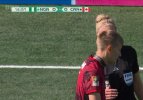
You are using an out of date browser. It may not display this or other websites correctly.
You should upgrade or use an alternative browser.
You should upgrade or use an alternative browser.
World Cup Nigeria vs Canada
- Thread starter Peter Grove
- Start date
Peter Grove
RefChat Addict
RefIADad
RefChat Addict

Q30: Brain Protection, FDA-Cleared Q-Collar
Q30 developed the Q-Collar - the only FDA-cleared sports and tactical equipment that helps protect brains from the effects of repetitive sub-concussive head impacts.
It’s very likely a device to help prevent concussions.
From a referee perspective, not a strong performance. Two cautionable offenses-one a borderline SFP red-called as simple fouls early under the FIFA “management directive”. From there, the temperature of the game went up. A pretty easy penalty call missed early in the second half but given after an on field review. The game got very heated late with a flurry of cards. Just a classic case of a referee not giving the right cards early and then tossing them for everything late because the game got away from her.
EDIT-the first screen grab was from the exact moment I was mentioning. 15th minute, and Quinn goes over the ball and gets a Nigerian player on the shin. Definite caution, and could be considered for a SFP send off. Yet this was just a talking to. A Nigerian caution was only a foul two minutes later, and things just went from there.
Last edited:
Ooooh yes it’s definitely one of those.
Q30: Brain Protection, FDA-Cleared Q-Collar
Q30 developed the Q-Collar - the only FDA-cleared sports and tactical equipment that helps protect brains from the effects of repetitive sub-concussive head impacts.q30.com
It’s very likely a device to help prevent concussions.
Just had a trawl through the match photos, they wore it during the warm-up too.
socal lurker
RefChat Addict
I'm more than a bit dubious about the science behind this . . . though if it actually works, it would definitely be a good thing . . .
Peter Grove
RefChat Addict
If it's really been proven to be as good as they claim it is, then it would seem that every football player (in fact all players in all sports where head impacts are a possibility) should wear one.I'm more than a bit dubious about the science behind this . . . though if it actually works, it would definitely be a good thing . . .
Peter Grove
RefChat Addict
According to this article on the Health News website, it looks like some others share your scepticism.I'm more than a bit dubious about the science behind this . . . though if it actually works, it would definitely be a good thing . . .
Q-Collar: A wearable device that may help protect the brain
For instance James Smoliga, a professor in the Department of Physical Therapy at High Point University, with a Doctorate of Philosophy (Ph.D.) in Sports Medicine, states as follows:
"I feel that the research behind the Q-Collar is highly flawed and the marketing claims are not accurate– [as] they are oversimplifications and exaggerations of peer-review research, and that research appears to have numerous inconsistencies, methodological fallacies, bias, and potentially even some ethical issues."
And as the article also points out:
Data do not show that the Q-Collar can prevent concussion or serious head injury.
socal lurker
RefChat Addict
It seems there is a lot more in the way of marketing various anti-concussion devices than there is good science as to devices that actually work. In the WWC last night, one of the Dutch players was wearing a padded swim cap (apparently created for synchronized swimming). I can't believe that would do anything at all for concussion protection. All the research I've seen on those padded hat things in soccer says they don't really do much if anything for concussions. I totally get where anyone who has had a concussion issue is desperate for a solution. I know high school age kids who have had to drop sports because of repeat concussions that put them at risk of long term problems, so it sure would be nice to get a solution. But as I understand the real issue in concussions isn't the contact, per se, but the rapid change in direction of the head itself, which causes the brain to slosh inside the skull. A small layer of padding doesn't meaningfully spread out the speed of that change of direction. The Q-collar is at least interesting in that it is trying a different approach, but I'm pretty dubious about the reality. Sure would be awesome though, if it worked. Finally, I think one of the concerns about pseudo-solutions is that they can give a false sense of security as players feel more safe than they should when they do reckless things.
Peter Grove
RefChat Addict
Pretty sure the Dutch player was only wearing the swim cap to keep the dressing in place after she sustained a head wound in a clash of heads.
socal lurker
RefChat Addict
Pretty sure the Dutch player was only wearing the swim cap to keep the dressing in place after she sustained a head wound in a clash of heads.
I can't say anything for sure but the announcers on the US feed said that it was a padded cap designed for synchronized swimming. While I don't have great faith in the announcers, it seems an odd thing to share if they didn't have some actual information.
Peter Grove
RefChat Addict
I watched them put it on her - it was a normal, unpadded swimming cap based on everything I could see. Among other things, the way it was wrinkling up, showed that. My daughter was a competitive swimmer for a number of years, so I know what a normal swimming cap looks like when worn.I can't say anything for sure but the announcers on the US feed said that it was a padded cap designed for synchronized swimming. While I don't have great faith in the announcers, it seems an odd thing to share if they didn't have some actual information.
I think those commentators were just guessing, and making things up.
The article below seems to agree with my take on it.
Did van de Donk wear the swim cap for a concussion?
No, van de Donk had to wear a swim cap during the Netherlands-U.S. Women's World Cup Game because she was bleeding from her head.
"The compression provided by the swim cap helps stop the bleeding and also prevents blood from getting on the player’s jersey," the medical staff of NJ/NY Gotham FC, a team in the National Women's Soccer League, said in a statement to TODAY.com.
Why did van de Donk wear a swim cap during the World Cup game against the U.S.?
Last edited:
socal lurker
RefChat Addict
Sigh. What a weird thing to come out of nowhere. There’s a reason I’m just as happy watching games on the Spanish language network without enough a Spanish to pick up more than an a few words here and there . . . .



